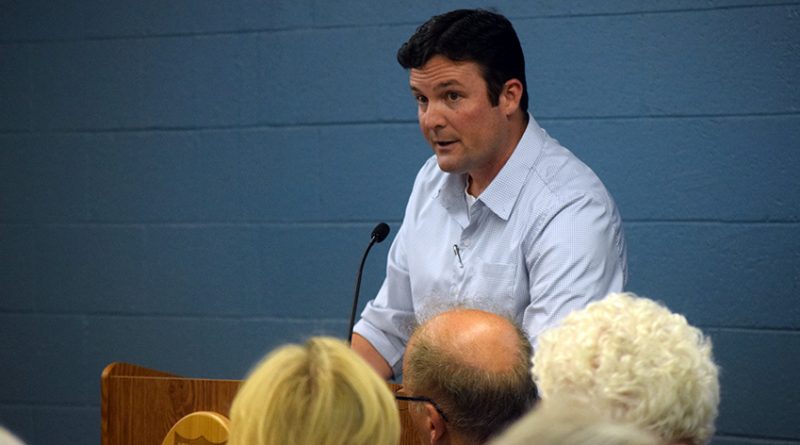Holman Column: Phased reopening best method to combat COVID-19
We’re a month away from Memorial Day when many of us here in Wisconsin feel safe enough to plant our annual, outdoor vegetable garden.
Experience, science, and historical trends tell seasoned gardeners that a hard frost will come in May, so while the precious growing window is small enough as it is, we wait. Why put in all the effort if a hard frost will just sweep in and erase it?
We find ourselves in a similar position with COVID-19 and reopening the economy, but before I touch on that, let’s take the agricultural metaphor one step further. No one would ask Portage County’s farming community—organic, conventional, or otherwise—to put their crops in the ground without having the ability to control pests or disease one way or another.
Farmers would laugh at the request because we know that plenty of pests are out there, waiting to strike. We also know that numerous diseases are latent in our environment and they, too, lie patiently in wait for the right conditions to thrive. Preparing fields and planting into them without the ability to control pests, weeds, or disease is a guaranteed loss of crop yield, guaranteed loss of revenue, and a guaranteed bad year on the farm.
Do you see where I’m going?
Let’s review some recent policy recommendations aimed at both fighting the COVID-19 pandemic and re-opening the economy. As is often the case these days, there is a little confusion, some distraction, and a lot of frustration when this kind of information comes out.
Still, there are some essential pieces that we should keep in the front of our minds as we think about our lives, our jobs, the economy, and the government’s actions in our collective struggle against this virus.
Topping the list of recommendations is the core need for states to be prepared. That includes assuring that hospitals can conduct robust testing and that they have the needed capacity to take care of current and/or future cases. Why? Like the gardeners and farmers planning around temperature, pests, or diseases, we know that the virus is out there.
We will have more cases when the economy is cautiously and appropriately re-opened for business, and we need to control the virus and its impacts on public health and the economy as best we can. That’s why these recommendations are all being set forth with the caveat that current restrictions could snap back into place if there’s a resurgence in COVID-19 cases.
There is also the need to see a consistent, two-week-long decline in infections before an area should re-open. We also need to be able to conduct rapid testing and contact tracing and have the ability to expand that to individuals who present “flu-like” symptoms and not just COVID-19 symptoms. Last, but not least, there is the need to have enough Personal Protective Equipment or “PPE”.
A conspicuous absence from these recommendations is a target date for reopening. That’s because the virus doesn’t play out across the community, state, or country in a uniform manner. It’s also not clear at this point which jurisdictions meet all the criteria being put out, so it would be premature and ill-advised to assign dates to states as if we could predict the future. That said, we do need to make steady progress on all of these recommendations and begin to implement our planning. So, who was it that made these policy recommendations?
These were recommendations set forth by the federal government. In other words, President Trump and his COVID-19 team. Soon after they were issued, Wisconsin followed in the federal government’s footsteps and announced its “Badger Bounce Back” plan. The state’s plan references the federal recommendations and—like the federal plan—follows a phased opening.
The federal plan even includes having governors within regions working together to re-open their state and regional economies, and they’re doing that. They’re working with different ‘start’ dates, but that’s because the situation in each state is different. We will learn from each other as different states go through their own processes. This includes states like Georgia, which have begun to open but are not in our region.
The reason I’m pointing all of this out is that the federal planning, state planning, and public health planning are all saying the same types of things. That’s important and reassuring, but it often gets lost in the 24-hour news cycle.
It’s abundantly clear that people and businesses are in a seriously challenging and overwhelming situation because of this virus. That’s why we need everyone on the same page. Striking a balance between public health realities and economic realities is never going to be easy, but it is easy to make the wrong move in this kind of situation. That could deteriorate the economy even further and endanger the public more than it is now.
So our effort, like the gardeners and farmers I started this piece out with, needs to focus on obtaining all we need to meet the criteria being set by the federal and state governments so that we can be more proactive and less reactive in our struggle against this disease.
If we can meet the criteria, that can help influence the decisions being made at every level. Even at a recent DHS press conference, Governor Evers—when asked by a reporter if the extended order could change—noted that it’s possible to reopen earlier if we have all of the capabilities that the federal government says we need and that we say we need based on our statewide experience(s) of COVID-19.
So, let me repeat the most important point in all of this. We are, contrary to what we often see or hear on the news, on the same page when it comes to how we fight this virus. Yes, unfortunately, there’s always the destabilizing forces of ego and politics to everything these days, and we should demand that politics stay out of this as much as possible.
We can fight the virus, preserve personal liberties, and move toward a healthier public and economy if we work together and lead with science and the law. Using one to subvert the other or attempting to follow several different plans with different criteria, different underlying information, and different guidelines are all a recipe for confusion and failure.
As we put aside our differences, let’s also keep in mind that the virus doesn’t care about politics or the law, plain and simple. It just wants to persist and to spread. We can help it out, and we can hinder it. As helpless as we’ve felt the past two months, we do have choices to make amidst all the uncertainty. What is certain is that divisive politics and divided communities will not get us out of this.
Psychologically, this has also taken a bigger toll than usual, as it has all happened at the end of a long, dreary winter. On top of that, it’s hard to feel optimistic when people around us are frustrated, support programs aren’t yet working as well as intended, and many people want to get back to work and a daily routine that feels normal. After all, it’s spring! The cold, rainy weather of April is here, and we all know that means that summer is right around the corner.
It doesn’t feel like it, but just like we know that warmer weather is on the horizon, the steady implementation of the Badger Bounce Back Plan is moving us closer to fully reopening the economy and improving the lives of Wisconsin residents.
So, I urge you to support the federal government’s recommendations, the state’s implementation of those recommendations through the Badger Bounce Back plan, and all efforts that support the same. We are showing that we can learn from the past, plan for the future, and perform in the present.
We are off to a good start, too, with the federal and state recommendations coming into alignment as they have, and just today, the Governor has issued Emergency Order #34 which relaxes the Safer-At-Home order a bit more and goes into effect at 8 a.m. on Wednesday, April 29.
Chris Holman is the Portage County Executive. He can be reached at [email protected] or 715-346-1997.


